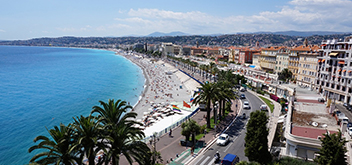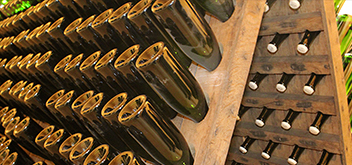No products
Grape varietes
The main grape variety in Provence is mourvèdre, which is the primary component in many red wines and rosés. Provence makes over 1,000 kinds of wines. It is often blended withgrenache and cinsault, with the latter being used as a significant component in most rosé.Cabernet sauvignon and syrah are more and more important, though traditional Provençal winemakers view those grapes with suspicion and a sign of globalization and appeal to international tastes.
In the XXth century, carignan was the major grape but as more producer aim for better quality the use of this high yielding grape has decreased. Other significant grape varieties, used in blending, includebraquet, folle, calitor and tibouren. The major white wine grapes of Provence include the Rhône varieties of bourboulenc,clairette, grenache blanc, marsanne andVviognier as well as chardonnay, sauvignon blanc, sémillon, rolle and ugni blanc.
Red and rosé grapes and their particularities
Syrah
These small, dark-red grapes with hints of blue produce dense and colorful wines, a bit harsh the first few years due to high tannin content, but very well-suited for aging. After a few years, these wines offer hints of vanilla, tobacco and candied red fruits.
Grenache
Originally from Spain but very common in thecoteaux-d’aix-en-provence wines, grenache confers subtle hints of red fruit to young wines. Over time, it produces more spicy and meaty notes. It gives wines greater body, fullness and intensity.
Cinsault
A very tasty and eye-catching grape that is native to Provence, traditionally eaten as a fruit. Widely used in Provence for rosé wine production, it provides freshness, fruitiness and subtlety to wines, and adds balance in combination with more hearty varietals.
Tibouren
This delicate and elegant grape is an authentic product of Provence. It provides the region’s rosés with subtle aromas and a full bouquet of fragrances. It is often the first choice for blending with other grapes that are native to the region.
Mourvèdre
These small, tightly-packed grapes flourish in hot climates with limestone soils.
Mourvedre grapes ripen slowly, enjoying the sea breezes as they mature to perfection.They produce full-bodied wines filled with character, and subtle tannins. When young, aromas of violets and blackberries abound. After years of aging, these wines are known for their smoothness, with characteristic notes of spice, pepper and cinnamon.
Carignan
Well adapted to poorer soils, carignan used to be widespread throughout Provence but is a bit harder to find these days. Grown mainly with low yields in the region’s foothills, it produces full-bodied and generous wines with vivid colors. It makes an
excellent base for assemblages.
Cabernet sauvignon
Quite rare in Provence, it offers well-structured tannins, powerful yet not aggressive, that are ideal for aging. Its characteristic fragrances of green pepper and blackcurrant set it apart from other vine types.
White wine grapes
Rolle (vermentino)
Originally from Liguria but grown in Provence since antiquity. It is an extremely hardy grape with a great taste, which produces wines with citrus and pear aromas, full-bodied and well-balanced, both smooth and flavorful.
Ugni blanc
Originally from Tuscany, these are round, juicy grapes that produce clear, fruity wines known for their elegance.
Clairette
A very ancient vine from Provence, which only yields small amounts of fruit. This oblong grape produces aromatic wines with an excellent bouquet and hints of white fruits.
Sémillon
A rambunctious, high-yield vine that can easily fall prey to rotting. Used only in small amounts, it produces full-bodied and full-flavored wines with a pronounced bouquet, offering elegant nuances of white flowers and honey.
Bourboulenc blanc (doillon)
This late-maturing grape is extremely hardy and rustic. Still quite rare in Provence, it gives wines a touch of elegance and a fuller taste.


















